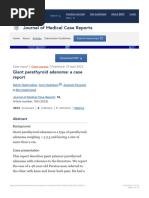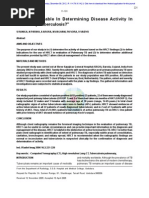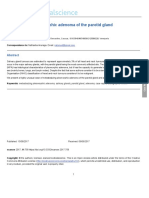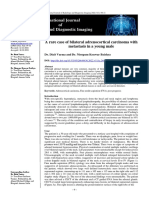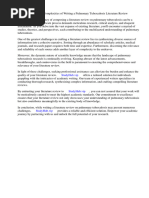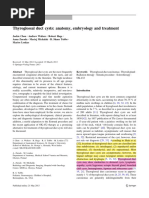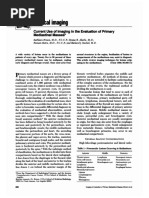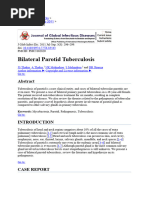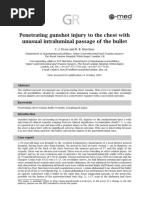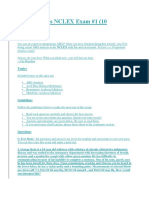E17 Full
E17 Full
Uploaded by
Sajit RawatCopyright:
Available Formats
E17 Full
E17 Full
Uploaded by
Sajit RawatOriginal Title
Copyright
Available Formats
Share this document
Did you find this document useful?
Is this content inappropriate?
Copyright:
Available Formats
E17 Full
E17 Full
Uploaded by
Sajit RawatCopyright:
Available Formats
The British Journal of Radiology, 85 (2012), e17e21
CASE REPORT
Infected tracheal diverticulum mimicking an aggressive mediastinal lesion on FDG PET/CT: an interesting case with review of the literature
1
M CHAREST,
MD,
C SIROIS,
MD,
Y CARTIER,
MD
and 4J ROUSSEAU,
MD
Nuclear Medicine Service, 2Department of Surgery, 3Diagnostic Radiology Service and 4Department of HematologyOncology, Hopital du Sacre-Coeur de Montreal, Montreal, QC, Canada
ABSTRACT. The differential diagnosis for intense hypermetabolic mediastinal lesions on positron emission tomography (PET) could benefit from the combined morphological and metabolic information present in a fluorodeoxyglucose (FDG) PET/CT study. We report a case of an infected tracheal diverticulum mimicking an FDG-avid malignancy in a patient with a history of chronic lymphoproliferative disease. We review the literature for a systematic approach in the differential diagnosis of cystic mediastinal lesions. The embryological development of the normal tracheobronchial tree is reviewed, followed by a presentation of various congenital and acquired mediastinal lesions. The characteristic CT findings are described for each lesion and the avidity for FDG on PET is mentioned when references are available. This case emphasises that complicated benign processes should be considered in the differential diagnosis of an FDG-avid mediastinal lesion, even in subgroups of patients with significant risk factors for malignancy.
Received 31 May 2010 Revised 14 February 2011 Accepted 23 February 2011 DOI: 10.1259/bjr/32814390
2012 The British Institute of Radiology
The value of fluorodeoxyglucose (FDG) positron emission tomography (PET) in the initial staging, assessment of recurrence, response to therapy and follow-up of various oncological disorders is well established. FDG PET has widespread use in the diagnosis and staging of non-small cell lung cancer, especially in nodal staging and distant metastatic disease assessment [13]. PET/CT imaging has evolved to become the modality of choice for staging lymphoma, assessing therapeutic response and establishing patient prognosis [4, 5]. The literature is continuously increasing on the role of FDG PET/CT in the assessment of known lesions. A differential diagnosis approach for an FDG-avid lesion in a specific anatomical region without knowledge of histology is not described as clearly. We report an interesting case of an infected tracheal diverticulum mimicking an FDG-avid malignancy. We review the literature for a systematic approach in the differential diagnosis of mediastinal lesions with cystic pattern that can present FDG uptake on PET studies.
Case report
A 74-year-old female presented to the emergency department following a recent fall. The patient had a history of chronic lymphoproliferative disease (Waldenstroms macroglobulinaemia) and a previous hip fracture. Although
Address correspondence to: Dr Mathieu Charest, Nuclear Medicine Service, Hopital du Sacre-Coeur de Montreal, 5400, boul. Gouin Ouest, Montreal, QC H4J 1C5, Canada. E-mail: mathieu. charest@gmail.com
the initial radiographs did not show any new fractures, a chest radiograph revealed a large mediastinal mass making the trachea deviate, which prompted further investigation. A chest CT (Figure 1) revealed a new right paratracheal mediastinal mass, which was not present on a chest CT performed 5 months earlier. This mass displaced the trachea and the oesophagus to the left, had a necrotic centre and was associated with small lymph nodes in the aortopulmonary window. The largest node was a 16 mm infracarinal node, there were unchanged 8 mm and 10 mm nodules in the spleen, a stable 2 cm node in the gastrohepatic ligament region and smaller stable retroperitoneal nodes. An FDG PET/CT (Figure 2) was performed for staging purposes to identify possible lymphoma transformation of known chronic lymphoproliferative disease. It revealed intense FDG activity at the periphery of a large mediastinal mass lesion that had a relatively hypometabolic centre. The metabolic lesion measured more than 5 cm in diameter and had a maximal standardised uptake value (SUV) of 9.2. It extended from the sternal notch following the right paratracheal groove inferiorly to the antecarinal area and displaced the trachea and the oesophagus to the left. The known aortopulmonary window and the infracarinal nodes were not associated with abnormal FDG uptake. There was uniform uptake in the spleen parenchyma and the known retroperitoneal nodes showed no abnormal activity. The differential diagnosis was a solitary doughnut-shaped hypermetabolic mediastinal lesion, which included active neoplasm and infectious process.
e17
The British Journal of Radiology, January 2012
M Charest, C Sirois, Y Cartier and J Rousseau
An exhaustive review of the patients chart revealed that on a chest CT performed a year earlier, a right posterior tracheal diverticulum had been mentioned incidentally (Figure 3). The tracheal diverticulum was first mentioned in December 2006, measured 15 mm in diameter and demonstrated typical air content with septation. As a result of mediastinoscopy and subsequent microbiological evaluation, the patient was diagnosed with an infected tracheal diverticulum. The abscess was drained and the patient hospitalised for intravenous antibiotic therapy. On a follow-up chest CT, a residual soft-tissue density remained visible in the upper mediastinum, but there was no evidence of aggressive behaviour in the interval. 6 months of clinical and radiographical followup confirm the benign, although important, nature of this mediastinal lesion.
Discussion
Figure 1. A chest CT performed at presentation showing a large right paratracheal mediastinal lesion displacing the trachea and the oesophagus to the left. Note the relatively hypodense necrotic centre.
Embryology
Ghaye et al [6] summarised the embryological development of the normal tracheobronchial tree. It usually starts at 2426 days as a median bulge of the ventral wall of the pharynx that develops at the caudal end of the laryngotracheal groove. At 2628 days, this bulge gives rise to right and left lung buds. As the lung buds elongate, the trachea is separated from the oesophagus
The infectious process differential was raised owing to the significant discrepancy in activity between the main lesion and the local and retroperitoneal nodes. At this point, a histological correlation was recommended.
Figure 2. Fluorodeoxyglucose positron emission tomography/CT selected images showing intense activity at the periphery of a
large mediastinal mass with a relatively hypometabolic centre. The lesion had a maximal standardised uptake value of 9.2. It extended from the sternal notch following the right paratracheal groove inferiorly to the antecarinal area and displaced the trachea and the oesophagus to the left.
e18
The British Journal of Radiology, January 2012
Case report: Infected tracheal diverticulum on PET/CT
Figure 3. A chest CT performed a few months earlier than that in Figure 1, demonstrating the uninfected tracheal diverticulum. Note the air density within the rounded lesion as well as the communication with the trachea, which is typical for a tracheal diverticulum.
by lateral ingrowths of the mesoderm. At 2830 days, the lung buds elongate into primary bronchi. At 3032 days, the 5 lobar bronchi appear as outgrowths of the primary bronchi. The lobar bronchi elongate at 3234 days and then rapidly branch to form all segmental bronchi by 36 days. Over the same period, the vascular supply to this tissue shifts from branches of the splenic plexus to definite pulmonary arteries as the lung bud plexus fuses with the sixth branchial arches [6, 7]. Berrocal et al [8] reviewed embryology, imaging key findings and pathology of various congenital anomalies of the tracheobronchial tree. They described the following tracheal anomalies: tracheomalacia, tracheal stenosis, tracheal bronchus, bronchial atresia and bronchogenic cyst. These are rare congenital malformations that are more frequently encountered in children.
herniation secondary to increased intraluminal pressure at a weak point of the tracheal wall. The congenital form occurs 45 cm below the true vocal folds or a few centimetres above the carina on the right side of the trachea. It usually contains smooth muscle and cartilage. During a CT scan, a communication with the tracheal lumen should be identified and the presence of cartilaginous rings within the wall of the diverticulum may help to determine if the lesion is congenital or acquired [1012]. Bronchogenic cysts are congenital lesions which are thought to originate from the primitive ventral foregut and may be mediastinal, intrapulmonary or less frequently in the lower cervical area. About two-thirds of bronchogenic cysts are located in the mediastinum. They represent 4050% of all congenital mediastinal cysts [13]. These cysts contain mucoid material and are lined by ciliated columnar or cuboidal epithelium. Their walls contain smooth muscle and often cartilage. If mediastinal, they may be located paratracheal (usually rightsided), carinal or hilar. They are most frequently located in the carina. They can also be found in the posterior and anterior mediastinum. If located in the anterior mediastinum, it may be necessary to distinguish them from cystic teratoma, thymic cysts or cysts derived from ectopic thyroids glands [8, 14, 15]. Bronchogenic cysts do not initially communicate with the tracheobronchial tree. Although most bronchogenic cysts in children are found incidentally, more than half are symptomatic. The symptoms vary with the size and the position of the cyst and may result from compression of the trachea or bronchi. This leads to coughing, wheezing, stridor, dyspnoea, cyanotic spells and pneumonia [8]. Infection occurs in 20% of cases with intraparenchymal cysts, usually secondary to communication with the tracheobronchial tree [16].
FDG-PET characteristics
Performing a Medline search for tracheal diverticulum and FDG did not yield any results. A search for bronchogenic cyst and FDG yielded a single reference. Sala and Coulden [17] report a case of bronchogenic cyst incidentally found on FDG PET/CT performed for pulmonary nodule evaluation. It demonstrated a photondeficient area in the subcarinal region that corresponded to a bronchogenic cyst on CT images. Although the SUV measurement of this anomaly was not given, only lowgrade uptake could be appreciated at the periphery of the doughnut-shaped lesion that demonstrated a cold centre.
Epidemiology
Tracheal diverticulum is relatively rare and accounts for about 2% of cases of air-filled cystic lesions in the neck. Goo et al [9] reported perhaps the largest series, with 64 proven cases. In previous literature, tracheal diverticulum has been described as paratracheal diverticulum, air cyst, bronchogenic cyst, tracheocele and lymphoepithelial cyst [10].
CT characteristics
The CT features of benign mediastinal cysts are a smooth, oval or tubular mass with a well-defined thin wall that usually enhances after intravascular administration of contrast material. The cysts show homogeneous attenuation, usually in the range of water attenuation (020 HU), with no enhancement of contents and no infiltration of adjacent mediastinal structures [7]. Oesophageal duplication cysts may share many of the features of bronchogenic cysts. To distinguish an oesophageal
e19
Histopathology
A diverticulum is lined by ciliated columnar epithelium and has a communication with the tracheal lumen. Two types of tracheal diverticula have been reported: acquired and congenital [11]. The acquired form is associated with chronic bronchopulmonary disease in the adult population and is thought to represent mucosal
The British Journal of Radiology, January 2012
M Charest, C Sirois, Y Cartier and J Rousseau
duplication cyst, its relation to the oesophagus should be assessed. Half of thoracic duplication cysts contain ectopic gastric mucosa. 99Tcm-pertechnetate may be of great value in the characterisation of such lesions [18], because the normal physiological distribution of pertechnetate is intense in gastric mucosa. The walls of pericardial cysts are composed of connective tissue, a single layer of mesothelial cells and they usually contain clear fluid. Pericardial cysts are invariably connected to the pericardium and the majority of them occur in the right anterior cardiophrenic angle [19]. However, they can be seen as high as the pericardial recesses at the level of the proximal aorta [20]. The cysts are asymptomatic in most patients. Most meningoceles are detected in adults [7]. During a CT scan they appear as well-defined, homogeneous lowattenuation paravertebral masses. Other possible findings include enlargement of intervertebral foramina and associated vertebral and rib anomalies or scoliosis [21]. Thymic cysts are uncommon and they can be congenital or acquired, unilocular or multilocular [22]. Simple congenital thymic cysts usually appear on a CT scan as well-defined water-attenuation masses with imperceptible walls [7]. Multilocular thymic cysts may appear as well-defined, heterogeneous cystic masses with clearly seen walls [23]. Some thymic cysts may demonstrate increased CT attenuation if a haemorrhage or an infection occurs and may be misdiagnosed as solid masses. Curvilinear calcification of the cyst wall occurs in a minority of cases [22]. Mature cystic teratomas (dermoid cysts) are cystic tumours derived from at least two of the three germ cell layers (ectoderm, mesoderm and endoderm). Cyst formation is typical and they are usually lined by tall mucus-secreting epithelial cells. The cysts are filled with sebaceous material and may contain hair. Mature cystic teratomas are the most common germ cell neoplasm. They occur more frequently in young adults. Most are asymptomatic and as a result are discovered incidentally. However, large tumours may cause chest pain, dyspnoea or other symptoms of compression [7]. The majority of dermoid cysts are in the anterior mediastinum, with only 38% occurring in the posterior mediastinum [24]. A fat fluid level within the mass is a finding that is highly specific to these cysts [7]. Lymphangiomas are rare (0.74.5% of all mediastinal tumours) benign congenital malformations consisting of focal proliferations of well-differentiated lymphatic tissue. They are most common in the neck and axilla, and about 10% extend into the mediastinum [25]. CT scans usually show a smooth lobulated mass which may mould to or envelope, rather than displace, the adjacent mediastinal structures [7]. Lymphangiomas usually have homogeneous low attenuation similar to water on a CT scan, but can also have a combination of fluid, solid tissue and fat. Calcification in lymphangiomas is rare [7]. The differential diagnosis must include tumours cystic degeneration either as a spontaneous process or following therapy, thymomas, Hodgkins disease, germ cell tumours, mediastinal carcinomas, lymph node metastases, nerve root tumours (schwannomas and neurofibromas) [7]. Finally, mediastinal abscesses are usually iatrogenic in nature following surgery, mediastinoscopy, an
e20
oesophageal perforation or secondary to the spread of infection from an adjacent structure. The abscesses may appear as low-attenuation masses on a CT scan owing to fluid content. Air bubbles, contiguity or communication with an empyema or subphrenic abscess and clinical features usually permit identification of the infectious processes [21].
Conclusion
This article reports an infrequent complication of a rare tracheal malformation. The combination of a good response to antibiotic therapy, the radiographic findings and the favourable clinical evolution confirms the diagnosis of an infected tracheal diverticulum that was mimicking an intense FDG-avid mediastinal malignancy on the initial FDG PET/CT study. This case emphasises that simple or complicated benign processes should always be considered in the differential diagnosis of an FDG-avid mediastinal lesion on FDG PET/CT. This diagnosis should be considered even in subgroups of patients with significant risk factors and a medical history of malignancy.
References
1. Quint LE. Staging non-small cell lung cancer. Cancer Imaging 2007;7:14859. 2. Fischer BM, Mortensen J. The future in diagnosis and staging of lung cancer: positron emission tomography. Respiration 2006;73:26776. 3. Ukena D, Hellwig D. Value of FDG PET in the management of NSCLC. Lung Cancer 2004;45:S758. 4. Allen-Auerbach M, de Vos S, Czernin J. The impact of fluorodeoxyglucose-positron emission tomography in primary staging and patient management in lymphoma patients. Radiol Clin North Am 2008;46:199211, vii. 5. Geus-Oei LD, Oyen WJG. Predictive and prognostic value of FDG-PET. Cancer Imaging 2008;8:7080. 6. Ghaye B, Szapiro D, Fanchamps J, Dondelinger RF. Congenital bronchial abnormalities revisited. Radiographics 2001;21: 10519. 7. Jeung M, Gasser B, Gangi A, Bogorin A, Charneau D, Wihlm JM, et al. Imaging of cystic masses of the mediastinum. Radiographics 2002;22:S7993. 8. Berrocal T, Madrid C, Novo S, Gutierrez J, Arjonilla A, GomezLeon N. Congenital anomalies of the tracheobronchial tree, lung, and mediastinum: embryology, radiology, and pathology. Radiographics 2004;24:e17. 9. Goo J, Im J, Ahn J, Moon W, Chung J, Park J, et al. Right paratracheal air cysts in the thoracic inlet: clinical and radiologic significance. AJR Am J Roentgenol 1999; 173:6570. 10. Rahalkar MD, Lakhkar DL, Joshi SW, Gundawar S. Tracheal diverticula report of 2 cases. Indian J Radiol Imaging 2004;14:1978. 11. Early EK, Bothwell MR. Congenital tracheal diverticulum. Otolaryngol Head Neck Surg 2002;127:11921. 12. Soto-Hurtado E, Penuela-Ruz L, Rivera-Sanchez I, Torres Jimenez J. Tracheal diverticulum: a review of the literature. Lung 2006;184:3037. 13. McAdams HP, Kirejczyk WM, Rosado-de-Christenson ML, Matsumoto S. Bronchogenic cyst: imaging features with clinical and histopathologic correlation. Radiology 2000;217: 4416. 14. Kim KW, Kim W, Cheon J, Lee HJ, Kim CJ, Kim I, et al. Complex bronchopulmonary foregut malformation: extralobar
The British Journal of Radiology, January 2012
Case report: Infected tracheal diverticulum on PET/CT
pulmonary sequestration associated with a duplication cyst of mixed bronchogenic and oesophageal type. Pediatr Radiol 2001;31:2658. Ashizawa K, Okimoto T, Shirafuji T, Kusano H, Ayabe H, Hayashi K. Anterior mediastinal bronchogenic cyst: demonstration of complicating malignancy by CT and MRI. Br J Radiol 2001;74:95961. Hantous-Zannad S, Charrada L, Mestiri I, Fennira H, Horchani H, Kammoun N, et al. Radiological and clinical aspects of bronchogenic lung cysts: 4 case reports. [In French.] Rev Pneumol Clin 2000;56:24954. Sala E, Coulden R. Incidental bronchogenic cyst detected on F-18 FDG positron emission tomography. Clin Nucl Med 2004;29:4945. Ferguson CC, Young LN, Sutherland JB, Macpherson RI. Intrathoracic gastrogenic cystpreoperative diagnosis by technetium pertechnetate scan. J Pediatr Surg 1973;8:8278. Feigin D, Fenoglio J, McAllister H, Madewell J. Pericardial cysts. A radiologic-pathologic correlation and review. Radiology 1977;125:1520. 20. Rogers CI, Seymour EQ, Brock JG. Atypical pericardial cyst location: the value of computed tomography. J Comput Assist Tomogr 1980;4:6834. 21. Glazer HS, Siegel MJ, Sagel SS. Low-attenuation mediastinal masses on CT. AJR Am J Roentgenol 1989;152:11737. 22. Strollo DC, Rosado de Christenson ML, Jett JR. Primary mediastinal tumors. Part 1: tumors of the anterior mediastinum. Chest 1997;112:51122. 23. Choi YW, McAdams HP, Jeon SC, Hong EK, Kim Y, Im J, et al. Idiopathic multilocular thymic cyst: CT features with clinical and histopathologic correlation. AJR Am J Roentgenol 2001;177:8815. 24. Rosado-de-Christenson ML, Templeton PA, Moran CA. From the archives of the AFIP. Mediastinal germ cell tumors: radiologic and pathologic correlation. Radiographics 1992;12:101330. 25. Faul JL, Berry GJ, Colby TV, Ruoss SJ, Walter MB, Rosen GD, et al. Thoracic lymphangiomas, lymphangiectasis, lymphangiomatosis, and lymphatic dysplasia syndrome. Am J Respir Crit Care Med 2000;161:103746.
15.
16.
17.
18.
19.
The British Journal of Radiology, January 2012
e21
You might also like
- Jurnal Bronchogenic AdenocarcinomaDocument4 pagesJurnal Bronchogenic AdenocarcinomaFarras ShandaNo ratings yet
- Simultaneous Papillary Carcinoma in Thyroglossal Duct Cyst and ThyroidDocument5 pagesSimultaneous Papillary Carcinoma in Thyroglossal Duct Cyst and ThyroidOncologiaGonzalezBrenes Gonzalez BrenesNo ratings yet
- Ectopic Cervical Thyroid Carcinoma-Review of The Literature With Illustrative Case SeriesDocument8 pagesEctopic Cervical Thyroid Carcinoma-Review of The Literature With Illustrative Case SeriesAnonymous s4yarxNo ratings yet
- Surgery Carotid TumorsDocument6 pagesSurgery Carotid TumorsVio VioNo ratings yet
- Med2023jun Adenoma BronquiolarDocument7 pagesMed2023jun Adenoma Bronquiolarchiconike19950620No ratings yet
- Anaplastic Transformation of Papillary Thyroid Carcinoma: A Rare But Fatal Situation (Case Report)Document5 pagesAnaplastic Transformation of Papillary Thyroid Carcinoma: A Rare But Fatal Situation (Case Report)IJAR JOURNALNo ratings yet
- Parathyroid Adenoma PDFDocument5 pagesParathyroid Adenoma PDFoliviafabitaNo ratings yet
- Giant-parathyroid-adenoma-a-case-report-Journal-of-Medical-Case-Reports-FulDocument18 pagesGiant-parathyroid-adenoma-a-case-report-Journal-of-Medical-Case-Reports-Fulkristaannebartolome12No ratings yet
- Is HRCT Reliable in Determining Disease Activity in Pulmonary Tuberculosis?"Document0 pagesIs HRCT Reliable in Determining Disease Activity in Pulmonary Tuberculosis?"Seftiana SaftariNo ratings yet
- Article TextDocument15 pagesArticle TextpbmaristelaNo ratings yet
- Craniopharyngiomas An Appropriate Surgical Treatment Based On Topographical and Pathological ConceptsDocument34 pagesCraniopharyngiomas An Appropriate Surgical Treatment Based On Topographical and Pathological ConceptsshokoNo ratings yet
- P NCDocument9 pagesP NCdandyderiNo ratings yet
- Case Reports TFDocument7 pagesCase Reports TFJulius OentarioNo ratings yet
- Malignant Phyllodes Tumor of The BreastDocument16 pagesMalignant Phyllodes Tumor of The BreastunknownNo ratings yet
- NotesDocument4 pagesNotesRaza HodaNo ratings yet
- medi-98-e14180Document4 pagesmedi-98-e14180fidzolcyber007No ratings yet
- Organizing Pneumonia: Chest HRCT Findings : Pneumonia em Organização: Achados Da TCAR de TóraxDocument7 pagesOrganizing Pneumonia: Chest HRCT Findings : Pneumonia em Organização: Achados Da TCAR de TóraxPutra PratamaNo ratings yet
- Tuberculous Peritonitis:what About Imaging: Poster No.: Congress: Type: AuthorsDocument9 pagesTuberculous Peritonitis:what About Imaging: Poster No.: Congress: Type: AuthorswurifreshNo ratings yet
- Bmhim 23 80 1 063-068Document6 pagesBmhim 23 80 1 063-068Karina CamachoNo ratings yet
- Jurnal Patologi AnatomiDocument5 pagesJurnal Patologi Anatomiafiqzakieilhami11No ratings yet
- Duktus ThyroglosusDocument13 pagesDuktus ThyroglosusOscar BrooksNo ratings yet
- A Rare Case of Bilateral Adrenocortical Carcinoma With Metastasis in A Young MaleDocument3 pagesA Rare Case of Bilateral Adrenocortical Carcinoma With Metastasis in A Young MaleDixit VarmaNo ratings yet
- Pulmonary Tuberculosis Literature ReviewDocument5 pagesPulmonary Tuberculosis Literature Reviewafdtvwccj100% (2)
- Jurnal Kanker Paru-ParuDocument11 pagesJurnal Kanker Paru-Parufidella uccaNo ratings yet
- Arteriovenous Malformation of The Thyroid Gland As A Very Rare Cause of Mechanical Neck Syndrome: A Case ReportDocument6 pagesArteriovenous Malformation of The Thyroid Gland As A Very Rare Cause of Mechanical Neck Syndrome: A Case ReportRifqi AnraNo ratings yet
- 39sangeeta EtalDocument4 pages39sangeeta EtaleditorijmrhsNo ratings yet
- IJRP 100931120222804 (1) - CompressedDocument7 pagesIJRP 100931120222804 (1) - CompressedKlinik Bpjs AthariNo ratings yet
- Thyroglossal Duct Cysts: Anatomy, Embryology and TreatmentDocument7 pagesThyroglossal Duct Cysts: Anatomy, Embryology and TreatmentTasia RozakiahNo ratings yet
- SJMCR 119 1711-1713Document3 pagesSJMCR 119 1711-1713Gedeon MotsaNo ratings yet
- Disseminated Necrotic Mediastinitis Spread From Odontogenic Abscess: Our ExperienceDocument10 pagesDisseminated Necrotic Mediastinitis Spread From Odontogenic Abscess: Our ExperienceVenter CiprianNo ratings yet
- Kak Rifda Ppds ParuDocument6 pagesKak Rifda Ppds ParuAsdar Raya RangkutiNo ratings yet
- Chist Canal TireoglosDocument7 pagesChist Canal TireoglosAurel OctavianNo ratings yet
- Primary Pure Squamous Cell Carcinoma of The Duodenum: A Case ReportDocument4 pagesPrimary Pure Squamous Cell Carcinoma of The Duodenum: A Case ReportGeorge CiorogarNo ratings yet
- Laryngeal Chondrosarcoma of The Thyroid Cartilage: Case ReportDocument5 pagesLaryngeal Chondrosarcoma of The Thyroid Cartilage: Case ReportelvirNo ratings yet
- 2009 Tumores DiafragmaDocument9 pages2009 Tumores DiafragmaJavier VegaNo ratings yet
- Pleural MesotheliomaDocument4 pagesPleural MesotheliomablawosusiNo ratings yet
- Skullbasesurg00008 0039Document5 pagesSkullbasesurg00008 0039Neetu ChadhaNo ratings yet
- Synchronous and Metastatic Papillary and Follicular Thyroid Carcinomas With Unique Molecular SignaturesDocument6 pagesSynchronous and Metastatic Papillary and Follicular Thyroid Carcinomas With Unique Molecular SignaturesTony Miguel Saba SabaNo ratings yet
- LIMITATIONS OF PET SCAN IN THE DETECTION OF DISTAL METASTASES OF BRONCHOPULMONARY CANCERDocument6 pagesLIMITATIONS OF PET SCAN IN THE DETECTION OF DISTAL METASTASES OF BRONCHOPULMONARY CANCERIJAR JOURNALNo ratings yet
- Postmedj00157 0004Document15 pagesPostmedj00157 0004mcramosreyNo ratings yet
- 1 s2.0 S0748798321001098 MainDocument6 pages1 s2.0 S0748798321001098 MainMihai MarinescuNo ratings yet
- Recurrent Adenocarcinoma of Colon Presenting As Duo-Denal Metastasis With Partial Gastric Outlet Obstruction: A Case Report With Review of LiteratureDocument5 pagesRecurrent Adenocarcinoma of Colon Presenting As Duo-Denal Metastasis With Partial Gastric Outlet Obstruction: A Case Report With Review of LiteratureVika RatuNo ratings yet
- Tacar High Resolution Computed Tomography of The LungsDocument79 pagesTacar High Resolution Computed Tomography of The Lungssindy suarezNo ratings yet
- 1752 1947 2 309 PDFDocument5 pages1752 1947 2 309 PDFHelen EngelinaNo ratings yet
- Brown 1990Document8 pagesBrown 1990PingKikiNo ratings yet
- Intussusceptionis in Adult, Case Report of Acute Intussusceptionon Due To Metastasis From A Testicular TumorDocument4 pagesIntussusceptionis in Adult, Case Report of Acute Intussusceptionon Due To Metastasis From A Testicular TumorIJAR JOURNALNo ratings yet
- An Unusual Presentation of Multiple Cavitated Lung Metastases From Colon CarcinomaDocument4 pagesAn Unusual Presentation of Multiple Cavitated Lung Metastases From Colon CarcinomaGita AmeliaNo ratings yet
- Adenosquamous Carcinomaof The Lung: Two Cases ReportDocument5 pagesAdenosquamous Carcinomaof The Lung: Two Cases ReportIJAR JOURNALNo ratings yet
- RadiopediaDocument4 pagesRadiopediakennyNo ratings yet
- Follicular Dendritic Cell Sarcoma of The Tonssilar About A CaseDocument4 pagesFollicular Dendritic Cell Sarcoma of The Tonssilar About A CaseInternational Journal of Innovative Science and Research TechnologyNo ratings yet
- Tex 1Document5 pagesTex 1Hernández Romero Samuel 6IM8No ratings yet
- Medicine: Lymphangiomatosis Involving The Pulmonary and Extrapulmonary Lymph Nodes and Surrounding Soft TissueDocument5 pagesMedicine: Lymphangiomatosis Involving The Pulmonary and Extrapulmonary Lymph Nodes and Surrounding Soft TissueAngel FloresNo ratings yet
- Parotid - TBC HakkındaDocument6 pagesParotid - TBC Hakkındadr.arzuozzNo ratings yet
- Laryngeal Plasmacytoma in Kahlers Disease: A Case ReportDocument6 pagesLaryngeal Plasmacytoma in Kahlers Disease: A Case ReportIJAR JOURNALNo ratings yet
- Pulmonary Pseudotumoral Tuberculosis in An Old Man: A Rare PresentationDocument3 pagesPulmonary Pseudotumoral Tuberculosis in An Old Man: A Rare PresentationNurhasanahNo ratings yet
- Penetrating Gunshot Injury To The Chest With Unusual Intraluminal Passage of The BulletDocument4 pagesPenetrating Gunshot Injury To The Chest With Unusual Intraluminal Passage of The BulletSummaiyahWahabKhanNo ratings yet
- The Management of Malignant Pleural Mesothelioma Single Centre Experience in 10 YearsDocument8 pagesThe Management of Malignant Pleural Mesothelioma Single Centre Experience in 10 YearsGabriela AndreeaNo ratings yet
- 2017 Article 996-2Document8 pages2017 Article 996-2chameleonNo ratings yet
- A Case Report and Literature ReviewDocument10 pagesA Case Report and Literature ReviewDerri HafaNo ratings yet
- OHS Act and Legal LiabilityDocument52 pagesOHS Act and Legal LiabilityMpho SelaiNo ratings yet
- Bahasa InggrisDocument15 pagesBahasa InggrisYovi pransiska JambiNo ratings yet
- Child Custody and Child SupportDocument32 pagesChild Custody and Child SupportNeven DomazetNo ratings yet
- Urinary Tract I-WPS OfficeDocument21 pagesUrinary Tract I-WPS Officekersameeksha borkerNo ratings yet
- English Proverbs & Sayings (Proverbs and Sayings Commonly Used in Everyday Conversation)Document8 pagesEnglish Proverbs & Sayings (Proverbs and Sayings Commonly Used in Everyday Conversation)Kamal Amin100% (1)
- Standard Analytical Protocol For Vibrio CholeraeDocument56 pagesStandard Analytical Protocol For Vibrio Choleraehoria_minea5905No ratings yet
- Application For LeaveDocument2 pagesApplication For Leavecsy123No ratings yet
- HSE-FM-05 Check List pERALATANDocument5 pagesHSE-FM-05 Check List pERALATANyudaNo ratings yet
- HazopDocument5 pagesHazopMohammed KhatibNo ratings yet
- ABG Analysis NCLEX ExamDocument5 pagesABG Analysis NCLEX ExamAngie MandeoyaNo ratings yet
- Microvascular Decompression As A Surgical Management For Trigeminal Neuralgia: Long-Term Follow-Up and Review of The LiteratureDocument8 pagesMicrovascular Decompression As A Surgical Management For Trigeminal Neuralgia: Long-Term Follow-Up and Review of The LiteratureAkmal Niam FirdausiNo ratings yet
- Ethics and Biomedical and PDF and PhilosophyDocument2 pagesEthics and Biomedical and PDF and PhilosophyTimNo ratings yet
- Bipolarity From Ancient To Modern Times: Conception, Birth and RebirthDocument17 pagesBipolarity From Ancient To Modern Times: Conception, Birth and RebirthMariano Outes100% (1)
- Terapi Farmakologi Gagal Jantung - Sept - 2020Document58 pagesTerapi Farmakologi Gagal Jantung - Sept - 2020FAUZAN ILHAM PRATAMANo ratings yet
- Speed and AgilityDocument13 pagesSpeed and AgilityJeneffer Estal FragaNo ratings yet
- Dark Triad Personality Dimensions A Literature RevDocument4 pagesDark Triad Personality Dimensions A Literature RevLehhno嵐No ratings yet
- Value Addition To Millets: OpinionDocument3 pagesValue Addition To Millets: OpiniondivakarNo ratings yet
- Application Guidelines For SNU President Fellowship Fall 2024Document3 pagesApplication Guidelines For SNU President Fellowship Fall 2024Enerel Otgonbayar (Eny)No ratings yet
- Psychosocial Approaches in Schizophrenia: Presenter: Dr.D.Archanaa Chairperson: Ms - NeethiDocument61 pagesPsychosocial Approaches in Schizophrenia: Presenter: Dr.D.Archanaa Chairperson: Ms - NeethidarchanaavigneshNo ratings yet
- SDS Premium EnglishDocument8 pagesSDS Premium EnglishbacabacabacaNo ratings yet
- What Is Counselling A Search For A DefinitionDocument2 pagesWhat Is Counselling A Search For A DefinitionNovianitaNo ratings yet
- Ryan V AG - 1964-3Document60 pagesRyan V AG - 1964-3monika awanNo ratings yet
- Jorge Bucay WIKIPEDIADocument3 pagesJorge Bucay WIKIPEDIAboobbbooboobolippooo0% (2)
- PRP Merit ListDocument29 pagesPRP Merit ListZuhaa KhanNo ratings yet
- Jadwal Oral Presentation Peserta FIT-VIIIDocument26 pagesJadwal Oral Presentation Peserta FIT-VIIIKlinik FellitaNo ratings yet
- Nanoreservorios Con L-Dopa para Su Liberación ControladaDocument1 pageNanoreservorios Con L-Dopa para Su Liberación ControladaTessy Maria Lopez GoerneNo ratings yet
- Nama: Albert Robertus Kelas: XII UPW 3 Mapel: English: Questions 16-18 Refer To The Following AnnouncementDocument12 pagesNama: Albert Robertus Kelas: XII UPW 3 Mapel: English: Questions 16-18 Refer To The Following AnnouncementRobertusalNo ratings yet
- Form Strongkids NewDocument2 pagesForm Strongkids NewNovalia Taulanda100% (3)
- Form of Application For Claiming Reimbursement of Medical Expenses of Government Servants and Their FamiliesDocument5 pagesForm of Application For Claiming Reimbursement of Medical Expenses of Government Servants and Their FamiliesAmit GautamNo ratings yet
- Pre Test Name: Class:: Read The Text and Answer Number 1 To 5!Document2 pagesPre Test Name: Class:: Read The Text and Answer Number 1 To 5!iisNo ratings yet







